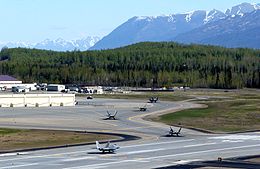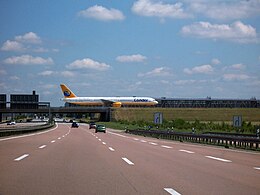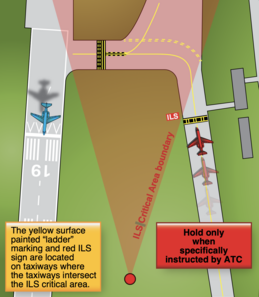90:
529:
383:
517:
336:
541:
46:
79:
57:
304:
505:
485:, unidirectional, steady-burning in-pavement lights installed across the entire taxiway at the runway holding position, and elevated steady-burning red lights on each side used in low visibility conditions (below 1,200 ft RVR). A controlled stop bar is operated in conjunction with the taxiway centerline lead-on lights which extend from the stop bar toward the runway. Following the ATC clearance to proceed, the stop bar is turned off and the lead-on lights are turned on.
316:
292:
68:
31:
493:
744:
406:
Holding position signs – A single solid yellow bar across a taxiway indicates a position where ground control may require a stop. If two solid yellow bars and two dashed yellow bars are encountered, this indicates a holding position for a runway intersection ahead; runway holding lines must never be
355:
Destination signs – black on yellow, similar to the direction signs. They indicate a destination at the airport and always have an arrow showing the direction of the taxi route to that destination. When the inscription for two or more destinations having a common taxi route are placed on a sign, the
228:
Black background with a yellow inscription and yellow and black border. Where necessary, these markings supplement location signs located alongside the taxiway and assist the pilot in confirming the designation of the taxiway on which the aircraft is located. These markings are located on the right
248:
These show where an aircraft should stop when approaching a runway from a taxiway. They consist of four yellow lines, two solid and two dashed, spaced six or twelve inches (15 or 30 cm) apart, and extending across the width of the taxiway or runway. The solid lines are always on the side where
214:
Taxiways, holding bays, and aprons are sometimes provided with paved shoulders to prevent blast and water erosion. Shoulders are not intended for use by aircraft, and may be unable to carry the aircraft load. Taxiway shoulder markings are yellow lines perpendicular to the taxiway edge, from taxiway
168:
to allow aircraft to leave the runway at higher speeds. This allows the aircraft to vacate the runway quicker, permitting another to land or take off in a shorter interval of time. This is accomplished by reducing the angle the exiting taxiway intercepts the runway at to 30 degrees, instead of 90
205:
Dashed markings define the edge of a taxiway on a paved surface where the adjoining pavement to the taxiway edge is intended for use by aircraft, e.g., an apron. These markings consist of a broken double yellow line, with each line being at least 15 centimetres (6 in) in width, spaced 15
407:
crossed without permission. At some airports, a line of red lights across a taxiway is used during low visibility operations to indicate holding positions. An "interrupted ladder" type marking with an "ILS" sign in white on red indicates a holding position before an ILS critical area.
201:
Continuous markings consist of a continuous double yellow line, with each line being at least 15 centimetres (6 in) in width, spaced 15 centimetres (6 in) apart. They divide the taxiway edge from the shoulder or some other abutting paved surface not intended for use by
239:
is below 1200 feet (370 m)). They are positioned to the left of the taxiway centerline in the direction of taxiing. Black inscription centered on pink circle with black inner and white outer ring. If the pavement is a light colour then the border is white with a black outer
187:
The enhanced taxiway center line marking consists of a parallel line of yellow dashes on either side of the taxiway centerline. Taxiway centerlines are enhanced for 150 feet (46 m) before a runway holding position marking. The enhanced taxiway centerline is standard at all
249:
the aircraft is to hold. There are three locations where runway holding position markings are encountered: Runway holding position markings on taxiways; runway holding position markings on runways; taxiways located in runway approach areas.
221:
Yellow background with a black inscription, provided when it is not possible to provide taxiway direction signs at intersections, or when necessary to supplement such signs. These markings are located on either side of the
455:. Taxiway Centerline Lights are spaced at either 50 or 100 foot intervals depending on the minimum authorized visibility. On curved taxiway segments, Taxiway Centerline Lights may be required to be closer together.
395:
Mandatory instruction signs are white on red. They show entrances to runways or critical areas. Vehicles and aircraft are required to stop at these signs until the control tower gives clearance to proceed.
437:
light. Taxiway edge lights are spaced at a minimum of 50 to a maximum of 200 feet apart. On straightaways, the spacing is typically 200 feet. These lights can be closer together at taxiway intersections.
433:
light. Where a road for ground vehicles only meets a taxiway or at an end of usable service area for a ramp or taxiway, the light at the edge of the road or the final taxiway edge light may emit
475:
lights installed on either side of the taxiway, or a row of in-pavement yellow lights installed across the entire taxiway, at the runway holding position marking at taxiway/runway intersections.
152:(though some do). There is a general rule on safe speed based on obstacles. Operators and aircraft manufacturers might have limits. Typical taxi speeds are 20–30 knots (37–56 km/h; 23–35 mph).
283:
Airport guidance signs provide direction and information to taxiing aircraft and airport vehicles. Smaller airports may have few or no signs, relying instead on airport diagrams and charts.
447:
light located along the taxiway centerline. Where a taxiway crosses a runway, or where a "lead-off" taxiway centreline leads off of a runway to join a taxiway, these lights will alternate
363:
Stop Bar signs – white on blue background. The designation consists of the letter S followed by designation of the taxiway on which the Stop Bar is positioned. This sign is not standard.
259:
These consist of two yellow solid lines spaced two feet (60 cm) apart connected by pairs of solid lines spaced ten feet (3 metres) apart extending across the width of the taxiway.
403:
Frequency change signs – Usually a stop sign and an instruction to change to another frequency. These signs are used at airports with different areas of ground control.
352:
Direction/Runway exit signs – black on yellow. Identifies the intersecting taxiways the aircraft is approaching, with an arrow indicating the direction to turn.
423:
used to outline the edges of taxiways during periods of darkness or restricted visibility conditions. These fixtures may be elevated or in-pavement and emit
662:
528:
83:
386:
The yellow "W2" direction sign in the foreground leading to the black "W2" location sign in the background. The blue "SW 2" sign is non-standard.
416:
For night operations, taxiways at major airports are equipped with lights, although many small airports are not equipped with taxiway lighting.
93:
Holding position sign (red sign saying "ILS") and marking (in front of the red plane) for instrument landing system (ILS) critical area boundary
89:
611:
400:
Runway signs – White text on a red background. These signs identify a runway intersection ahead, e.g., runway 12-30 in the photo above.
756:
275:
The taxiways are given alphanumeric identification. These taxiway IDs are shown on black and yellow signboards along the taxiways.
705:
429:
light normally. Where a four-way intersection crosses, the light at the centre of the crossing may be omnidirectional and emit
349:
Location signs – yellow on black background. Identifies the runway or taxiway the aircraft is currently on or is entering.
516:
206:
centimetres (6 in) apart (edge to edge). These lines are 15 feet (4.6 m) in length with 25 foot (7.6 m) gaps.
782:
691:
768:
727:
567:
540:
504:
685:
189:
588:
50:
198:
Used to define the edge of the taxiway when the edge does not correspond with the edge of the pavement.
271:
Red background signs with a white inscription to supplement the signs located at the holding position.
748:
254:
382:
339:
The signs can often be combined, in this case a direction sign, a location sign, and a runway sign.
38:
17:
335:
169:
degrees, thus increasing the speed at which the aircraft can exit the runway onto the taxiway.
492:
8:
236:
663:"FAA Advisory Circular No: 150/5340-1J March 31, 2008 – Standards for Airport Markings"
45:
134:
126:
122:
78:
181:
A single continuous yellow line, 15 to 30 centimetres (6 to 12 in) in width.
265:
These consist of a single dashed line extending across the width of the taxiway.
72:
56:
776:
114:
769:
https://www.faa.gov/documentLibrary/media/Advisory_Circular/150-5340-30J.pdf
235:
These markings are located at points along low visibility taxi routes (when
367:
303:
34:
315:
291:
718:(LLBG AD 2.9 Surface Movement Guidance and Control System and Markings)
638:
375:
357:
67:
30:
616:
371:
557:
130:
102:
61:
329:
149:
106:
743:
562:
138:
118:
110:
125:
and other facilities. They mostly have a hard surface such as
142:
425:
263:
Holding
Position Markings for Taxiway/Taxiway Intersections
757:"TSB Canada Recommends Taxiway Changes At Toronto Pearson"
253:
Holding
Position Markings for Instrument Landing System (
148:
Most airports do not have a specific speed limit for
589:"Airplanes: At what speed do planes generally taxi?"
465:lights installed at holding positions on taxiways
774:
754:
612:"Ask the Captain: Making time on the taxiways"
390:
343:
687:Pilot's Handbook of Aeronautical Knowledge
332:at airports, with several types of each:
82:Holding Position Marking on a taxiway at
609:
381:
334:
88:
77:
66:
55:
44:
29:
366:Other – many airports use conventional
219:Surface Painted Taxiway Direction Signs
14:
775:
269:Surface Painted Holding Position Signs
215:edge to pavement edge, about 3 metres.
192:Part 139 certified airports in the US.
27:Path for moving aircraft at an airport
674:(canceled and replaced by150/5340-1K)
471:Either a pair of elevated flashing
24:
684:"Chapter 14: Airport Operations".
639:"FAA TV: High Speed Exit Taxiways"
160:Busy airports typically construct
155:
25:
794:
736:
461:Three in-pavement steady-burning
443:They are steady burning and emit
356:destinations are separated by an
309:Direction Sign Onto Taxiway Bravo
742:
539:
527:
515:
510:Taxiway Centerline Light (Inset)
503:
491:
314:
302:
290:
246:Runway Holding Position Markings
692:Federal Aviation Administration
360:(•) and only one arrow is used.
49:Aircraft taxiing to runway, at
755:Sean Broderick (Feb 4, 2019).
721:
698:
677:
655:
631:
610:John Cox (November 23, 2014).
603:
581:
568:Pavement Classification Number
226:Surface Painted Location Signs
13:
1:
574:
378:signs throughout the airport.
706:"AIP Israel Amendment 2.5-1"
233:Geographic Position Markings
7:
690:(FAA-H-8083-25C ed.).
551:
391:Mandatory instruction signs
297:Location Sign for a Taxiway
172:
10:
799:
441:Taxiway Centerline Lights:
344:Operational guidance signs
694:. 2023-07-17. p. 12.
546:Taxiway Lights at Atlanta
411:
328:There are two classes of
278:
534:Taxiway Lights at Night
229:side of the centerline.
137:airports sometimes use
60:A taxiway crossing the
783:Airport infrastructure
729:, Page 2-7, Table 2-1.
522:Taxiway Lights at Dusk
387:
340:
212:Taxi Shoulder Markings
94:
86:
75:
64:
53:
42:
761:Aviation Week Network
459:Clearance Bar Lights:
385:
338:
196:Taxiway Edge Markings
92:
81:
70:
59:
48:
33:
751:at Wikimedia Commons
469:Runway Guard Lights:
421:Taxiway Edge Lights:
708:. December 16, 2010
237:Runway visual range
185:Enhanced Centerline
166:rapid-exit taxiways
133:, although smaller
591:. February 9, 2016
498:Taxiway Edge Light
388:
341:
95:
87:
76:
65:
54:
43:
747:Media related to
179:Normal Centerline
16:(Redirected from
790:
764:
746:
730:
725:
719:
717:
715:
713:
702:
696:
695:
681:
675:
673:
671:
669:
659:
653:
652:
650:
649:
635:
629:
628:
626:
624:
607:
601:
600:
598:
596:
585:
543:
531:
519:
507:
495:
479:Stop Bar Lights:
318:
306:
294:
135:general aviation
21:
798:
797:
793:
792:
791:
789:
788:
787:
773:
772:
739:
734:
733:
726:
722:
711:
709:
704:
703:
699:
683:
682:
678:
667:
665:
661:
660:
656:
647:
645:
637:
636:
632:
622:
620:
608:
604:
594:
592:
587:
586:
582:
577:
554:
547:
544:
535:
532:
523:
520:
511:
508:
499:
496:
414:
393:
346:
326:
325:
324:
323:
322:
319:
311:
310:
307:
299:
298:
295:
281:
175:
158:
156:High-speed exit
28:
23:
22:
15:
12:
11:
5:
796:
786:
785:
766:
765:
752:
738:
737:External links
735:
732:
731:
720:
697:
676:
654:
630:
602:
579:
578:
576:
573:
572:
571:
565:
560:
553:
550:
549:
548:
545:
538:
536:
533:
526:
524:
521:
514:
512:
509:
502:
500:
497:
490:
487:
486:
476:
466:
456:
438:
413:
410:
409:
408:
404:
401:
392:
389:
380:
379:
364:
361:
353:
350:
345:
342:
320:
313:
312:
308:
301:
300:
296:
289:
288:
287:
286:
285:
280:
277:
273:
272:
266:
260:
250:
242:
241:
230:
223:
216:
209:
208:
207:
203:
193:
182:
174:
171:
157:
154:
101:is a path for
84:Mumbai Airport
73:Munich Airport
26:
9:
6:
4:
3:
2:
795:
784:
781:
780:
778:
771:
770:
762:
758:
753:
750:
745:
741:
740:
728:
724:
707:
701:
693:
689:
688:
680:
664:
658:
644:
640:
634:
619:
618:
613:
606:
590:
584:
580:
569:
566:
564:
561:
559:
556:
555:
542:
537:
530:
525:
518:
513:
506:
501:
494:
489:
488:
484:
480:
477:
474:
470:
467:
464:
460:
457:
454:
450:
446:
442:
439:
436:
432:
428:
427:
422:
419:
418:
417:
405:
402:
399:
398:
397:
384:
377:
373:
369:
368:traffic signs
365:
362:
359:
354:
351:
348:
347:
337:
333:
331:
321:No Entry Sign
317:
305:
293:
284:
276:
270:
267:
264:
261:
258:
256:
251:
247:
244:
243:
238:
234:
231:
227:
224:
220:
217:
213:
210:
204:
200:
199:
197:
194:
191:
186:
183:
180:
177:
176:
170:
167:
163:
153:
151:
146:
144:
140:
136:
132:
128:
124:
120:
116:
112:
108:
104:
100:
91:
85:
80:
74:
69:
63:
58:
52:
51:Dubai Airport
47:
40:
39:Elmendorf AFB
36:
32:
19:
767:
760:
723:
710:. Retrieved
700:
686:
679:
666:. Retrieved
657:
646:. Retrieved
642:
633:
621:. Retrieved
615:
605:
593:. Retrieved
583:
482:
478:
472:
468:
462:
458:
452:
448:
444:
440:
434:
430:
424:
420:
415:
394:
327:
282:
274:
268:
262:
252:
245:
232:
225:
218:
211:
195:
184:
178:
165:
161:
159:
147:
98:
96:
41:, Alaska, US
35:F-22 Raptors
643:www.faa.gov
109:connecting
71:Taxiway at
37:taxiing at
712:January 1,
668:January 1,
648:2021-03-25
623:January 1,
595:January 1,
575:References
358:interpunct
162:high-speed
617:USA Today
481:A row of
202:aircraft.
123:terminals
777:Category
749:Taxiways
558:Aviation
552:See also
370:such as
222:taxiway.
173:Markings
131:concrete
103:aircraft
62:Autobahn
18:Taxiways
330:signage
150:taxiing
127:asphalt
119:hangars
111:runways
107:airport
99:taxiway
563:Runway
473:yellow
463:yellow
449:yellow
431:yellow
412:Lights
139:gravel
115:aprons
105:at an
570:(PCN)
453:green
445:green
376:yield
279:Signs
240:ring.
143:grass
113:with
714:2018
670:2018
625:2018
597:2018
451:and
426:blue
374:and
372:stop
483:red
435:red
255:ILS
190:FAR
164:or
141:or
129:or
779::
759:.
641:.
614:.
145:.
121:,
117:,
97:A
763:.
716:.
672:.
651:.
627:.
599:.
257:)
20:)
Text is available under the Creative Commons Attribution-ShareAlike License. Additional terms may apply.















